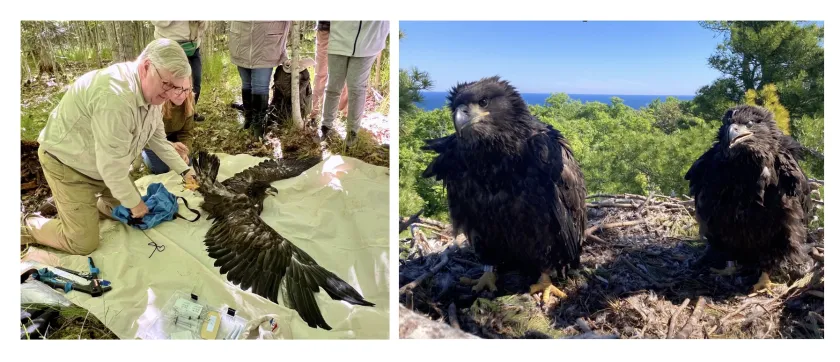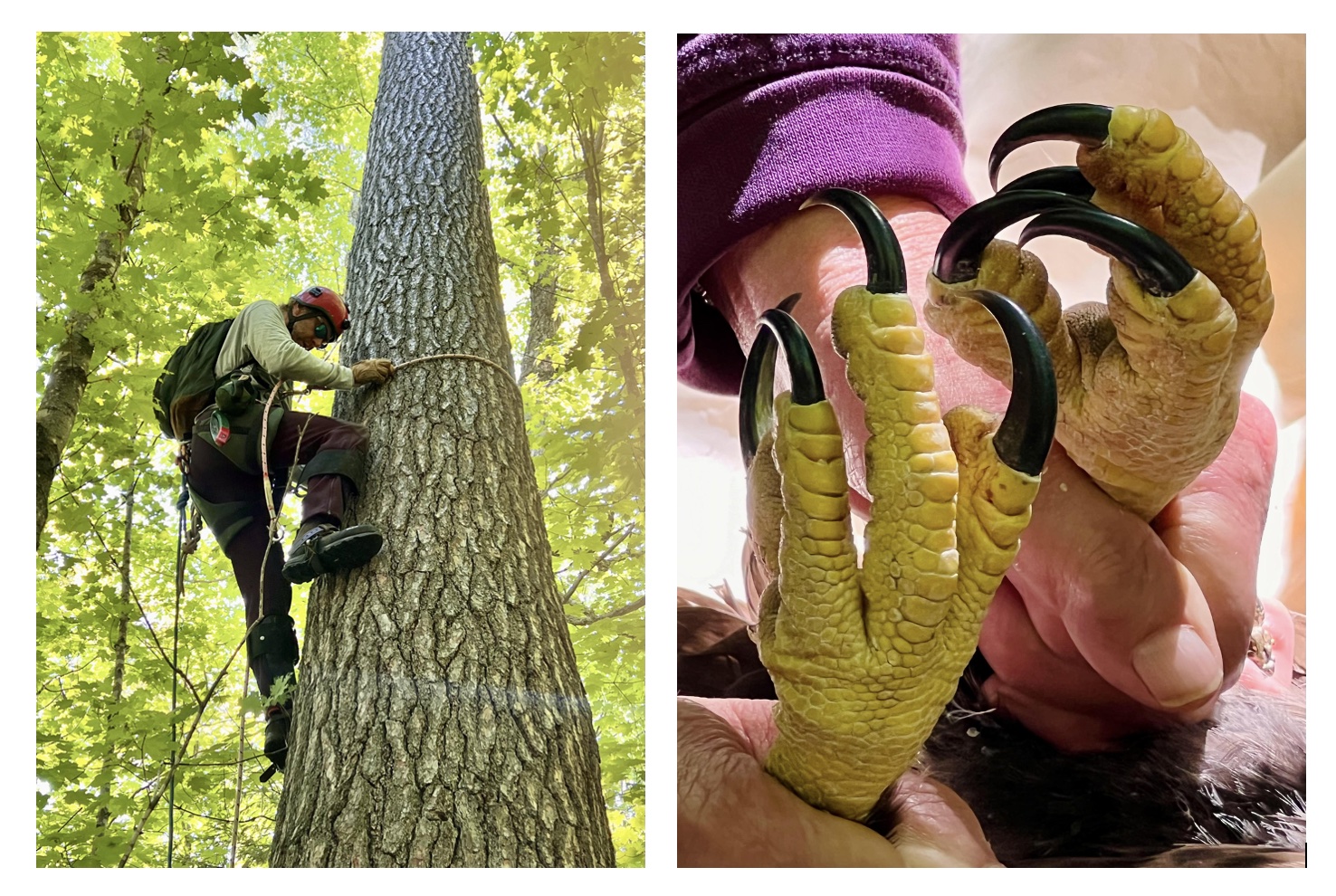A small group hiked into a wooded area in Marquette County early this week, straining their necks to gaze upward in search of the desired nest perched near the top of a towering white pine. Within it were two larger-than expected bald eaglets, about nine weeks old and on the verge of flying. It was a small window of opportunity to band the birds and collect data that sheds light on their population changes related to climate change, chemicals, disease and other factors. “Eagles are our messengers of the environment; they tell us how healthy everything is,” said renowned researcher and Northern Michigan University alumnus William Bowerman. He is leading a banding effort along Lake Superior this summer with help from NMU alumnus Mike Wierda.
This is Bowerman's 40th year of studying bald eagle ecology. His groundbreaking approach and dedication to preserving sea eagle populations around the world earned him the 2023 Lowell Thomas Award from The Explorers Club, an international professional society dedicated to the advancement of field research, scientific exploration and resource conservation.
He and Wierda employ a tag team-style approach to the banding process. Wierda climbs the tree until he reaches the nest, pulls an eaglet toward him with a tripod leg equipped with a small hook, and places it in an eagle bag that he lowers to the ground.
Bowerman waits beneath for the delivery, unhooks the bag and brings it to a ground tarp topped by his gear. He gently removes the nestling and progresses through a series of steps. Once he nears the end of processing the bird, Wierda gets to work securing the second chick, all while the mother eagle circles anxiously above. Because eagles have no sense of smell, Bowerman said the mother will return to her chicks after they have been handled by human scientists and tagged with a riveted metal Fish and Wildlife Service band.
“We draw up to 12ccs of blood from the wing, pluck three breast feathers to test for mercury, then measure the eaglet's beak, feathers and feet to see if it's a male or female,” said Bowerman (there was one of each on this day). “Then we can age them. The third big feather from the end—that growth rate tells us how old they are. We've used that age for climate change by then determining when the first eggs were lain in nests over 30 years.”
Bowerman said researchers have looked at more than 5,000 first eggs laid in nest sites over that three-decade period, and found the Great Lakes eagles have been nesting one day earlier each year. A new study is determining if nestling size is also changing due to heat stress.
“Eagles are the messenger for climate change and contaminants, and we are now looking at the role of disease,” he added. “The only thing that has ever scared me happened last year, when we saw how vast parts of Michigan did not have eagles nesting. We were supposed to collect 30 samples along Lake Superior last year and we only got 11. We have lost a significant portion of our nesting eagle population in the state. If we weren't surveilling them, we wouldn't know that had occurred.
"To fill in the gaps, we asked Michigan United Conservation Clubs (MUCC) and Michigan Audubon members to help us by filling out a survey. Long-term data is the key to understanding the impacts and without our monitoring project, which is funded by the Great Lakes Restoration Initiative, we would never have observed this event.”
Bowerman said scientists know about eagles' sensitivity to chemicals based on many studies. When pesticides and PCBs were banned in the 1970s, he said there was a precipitous decline in toxins and the eagle population took off. Mercury levels in the birds fluctuate “because we have an airshed that includes China,” he said, so depending on industry activity in that nation, researchers will see peaks and dips in feather concentrations of mercury.
“There are also variations in mercury if you impound water and have a lot of fluctuating water levels,” he said. “You get a lot of plants and other biological material, and then when you flood it, it increases the methylation of mercury. The International Joint Commission had been managing the water levels at Voyageurs National Park. Its mercury averaged 20 ppm in feathers when everywhere else in the Great Lakes was eight. They decreased the water level fluctuation at Voyageurs and the next year and it went down to eight. So eagles are very sensitive."
For a number of Great Lakes Areas of Concern (AOCs), eagles are used as one of the wildlife indicators, Bowerman added. If they are healthy and the levels of contaminants are low, then they can delist AOCs. That is why they still maintain eagle surveys for about one-third of Michigan.
Bowerman is a professor of wildlife ecology and toxicology and former chair of the Department of Environmental Science and Technology at the University of Maryland. He began exploring the effects of environmental pollutants in the Great Lakes region in 1984, and has since become a world-renowned champion of avian conservation through environmental monitoring programs on every continent except Antarctica. Passionate about sharing his expertise, he also mentors graduate and undergraduate students who partner in this work—including some from NMU—in many research projects.
Wierda was one of Bowerman's doctoral students at Clemson University and became involved in the long-running eagle banding project in Michigan in 2004. He holds two degrees from Northern: a 2002 bachelor's in Zoology and a 2008 master's in Biology. He recently obtained tenure as an associate professor and director of the Pesticide Safety Education Program at Utah State University Extension. He works with people who spray pesticides for a living, rewriting and updating safety materials and providing CEUs for people trying to maintain their pesticide licenses.
“Bill called me last spring asking if I knew of any climbers and I said I still had some gear,” Wierda said. “I came back last May after a 14-year hiatus of climbing trees to see if I still had the skills necessary, and happily joined again this spring. For about five years, I ran the program as Bill's doctoral student and post-doc and handled all the logistics. It's nice to work with him again, but not have to be the person to figure things out. I get all the fun of being in the field, climbing trees and enjoying quality time in the woods.”
Wierda reflected fondly on his NMU experience. One highlight was completing his master's thesis on pileated woodpecker foraging ecology under the guidance of Professor Jackie Bird in the Upper Peninsula (Duke's) Experimental Forest.
“That was a great experience,” he said. “It's funny how much that past woodpecker work helps with this banding project. When you're studying woodpecker foraging, you get really good at looking at trees and assessing their state of decay and their healthiness. That's really important when you're ascending 70-90 feet up a tree toward a nest. You can decide, ‘No, there's too much fungal rot here, so I better pass on this one.'”
The duo just arrived at Voyageurs National Park for additional research. Bowerman is slated to be interviewed by a Washington Post reporter about the impact of avian influenza on eagle populations.
Both men had learned from the late NMU biology professor Bill Robinson, whether in the classroom, field or both. Because of that connection, Rebecca Tavernini, Robinson's daughter and director of publications in NMU Marketing and Communications, was selected for the honor of holding the legs of one eaglet while Bowerman processed it.
"It was an incredible experience I'm so grateful to have been a part of," she said. "It's clear Bill and Mike enjoy sharing their passions with others, just like my dad did. I'm thrilled that his legacy of conservation, and just having dang fun in the woods, continues on."


